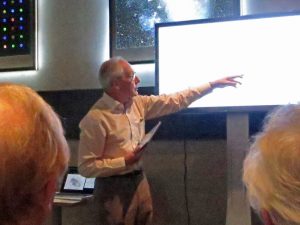April 2, 2017
“The Hubble Space Telescope: Restoring the Image” – History of Astronomy Group Meeting – 28th March 2017
Report by: Mike Dryland
 The talk to the History of Astronomy Group was a bit off-piste this time. As Eddie said in his introduction, it could be argued that the subject was neither history nor astronomy. But for a subject so central to modern astronomy any exception was well worthwhile. As well as capturing the public’s imagination as never before, the Hubble Space Telescope has been at the very vanguard of many key advances in astronomy. And it was, so nearly, a very expensive failure.
The talk to the History of Astronomy Group was a bit off-piste this time. As Eddie said in his introduction, it could be argued that the subject was neither history nor astronomy. But for a subject so central to modern astronomy any exception was well worthwhile. As well as capturing the public’s imagination as never before, the Hubble Space Telescope has been at the very vanguard of many key advances in astronomy. And it was, so nearly, a very expensive failure.
Soon after the long-awaited launch of Hubble in 1990 it was realised that the telescope was out of focus. Shock, horror! How could this be?
Dr Edward Yeadon was close to the action. Although he didn’t work on Hubble itself, Eddie was a professional physicist who was working on optics in the US at the time, for the very company which had done the polishing on the Hubble mirror. He has many insights on the Hubble project, including about the influence exerted by corporate and defense industry culture. For the first time, thanks to Eddie’s carefully constructed talk, I think I understood how Hubble’s problem came about, and how, to astronomy’s great relief, it was fixed.
To cut a long story short, Hubble’s 2.5m primary mirror had been incorrectly figured (polished in the wrong shape) due to a tiny error in part of the test equipment used to monitor and direct the final polishing. The test interferometer used a correcting lens system, called a ‘null lens’, so that Hubble’s hyperbola-shaped mirror could be compared with a standard precise spherical mirror. The ‘null lens’ in fact was itself a complex system of mirrors which had to be constructed very precisely in relation to each other. Inside the null lens system, a spacing rod had been assembled in error about 1mm out of position due to a paint chip! There was no final full system test of Hubble’s optical system – that was eliminated to save money, and Hubble was launched with the resulting faulty mirror.
Analysis of the images was able to diagnose the error which was systematic i.e. a predictable distortion. Initially, the team was able to develop software to process the images and this improved resolution to about equal the best ground-based telescopes. This was valuable because, being in orbit above Earth’s atmosphere, Hubble could observe in many wavelengths not visible on the ground. But performance was still far below expectations – Hubble should have delivered resolution ten times better than ground-based telescopes.
A team was created to design an optical system to be fitted to Hubble and correct the error. The result was the COSTAR package – ‘Corrective Optics Space Telescope Axial Replacement’ (something of a stretch even for world-beating US acronym engineers!). COSTAR was a machine the size of a telephone box needed to position and control just three small millimetre-sized mirrors which could correct the aberration. COSTAR was fitted during a scheduled servicing mission by the Space Shuttle in 1993.
The rest is history. Hubble has been producing breath-taking images that have advanced our knowledge by leaps and bounds and captured the popular imagination. Hubble has been updated several times in orbit and new instruments embodied their own corrective optics. COSTAR became redundant and was removed in 2009.
Hubble was launched in 1990 with a design life of 15 years. It has now been delivering fantastic images for 27 years and may well be good for another 5-10 years.
Many thanks to Eddie for a challenging, clear and insightful talk.
Posted under: Flamsteed, History of Astronomy, Meeting Report










You must be logged in to post a comment.